
















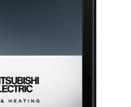






























































Whether it’s a ductless unit, floor unit, ceiling cassette, or air handler, we provide comfort and filtration to every room, with maximum energy e ciency. Get peace of mind with our 3-year labor, and 12-year parts warranty, plus we o er full service on everything we install. Contact us today to learn more about which heating and cooling options would work best for you and your home.


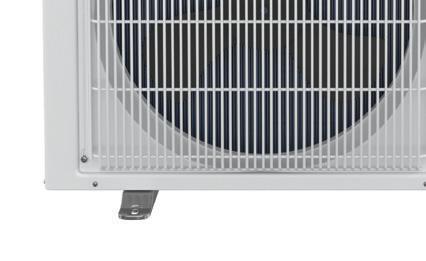
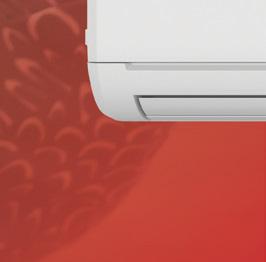


As we publish the fifth annual Clean Power Guide, it’s stunning to realize how far the entire field of renewable energy and clean technology has come. This is due substantially to policy commitments like California’s and New York’s, with timelines to wean these major economies completely off fossil fuels. And with the Biden administration’s recent climate investment package, opportunities will continue to grow—especially in the form of tax credits.
When we launched in 2018, who knew that there would be over 60 makes and models of electric vehicles on the market today, some of them cost-competitive with internalcombustion cars? Who knew that the largest solar developer, Nextera Energy, would (briefly) eclipse Exxon-Mobil in market valuation?
Today, you can buy an air-source heat pump at Home Depot,
and the price of geothermal is falling rapidly. So many homes now have battery storage systems with their solar panels that SunRun was recently able to create a “virtual power plant” pulling power from these systems into the grid to meet peak energy demand. Whether you are into the tech, the savings, or the necessity of fast action on climate change, there are good reasons to be excited.
We’re delighted to bring you a rich menu of articles and interviews that showcase clean power options for your home or business. And we are honored to be working with some of the same sponsors that were with us when we launched.
As always, the Clean Power Guide is available in the Winter issue of Upstate House in print, and online, well, forever. We will be printing 10,000 copies for distribution at educational events (holler if your school or workplace can use some). We are eager to bring this content into events with new partners—like you!
January 19, 2023
As the climate wake-up appears more and more serious, federal, state and private investment dollars are flowing into the clean energy marketplace. What growth—and maturity—is ahead, and what efforts are needed to make sure everybody shares in the opportunity? A Chronogram Conversation with Sustainable Hudson Valley and special guests.
Find more information and resources at Sustainhv.org and Upstatehouse.com.

Today, homeowners all over New York state are hearing about how various state programs and policies will be affecting their lives. Many criticize this focus on the homeowner, saying that it should be the responsibility of the state and the corporations that many see as responsible for the increased amount of carbon dioxide in the atmosphere.
The sustainable transition that New York State is experiencing, however, will not discriminate between current and previous emitters of carbon dioxide. Between the acronyms, technical language, and companies selling products, it can be confusing for homeowners to identify the things that are truly important for them to help by transitioning their own homes.
Here is a snapshot of the important technologies, their costs, and the incentives that will help you transition your own home. This transition should take place based on your time and budget, and the table on the next page presents opportunities and incentives that are available now, and after the implementation of the Inflation Reduction Act (IRA) in 2023. These incentives are subject to change, so there may be additional incentives to take advantage of.
One of the costlier upgrades to the home, insulation and air sealing can be the single most energy-efficient and cost-effective home upgrade. Ensuring your home is equipped for the winter temperatures by sealing up a home that is leaking heat will not only keep your home warmer, but will save you money, as your heating system will not work as hard to produce warm temperatures.
Residential
Many see solar panels as the quickest way to power your home with renewable energy. While it may be simple to do, this can often be expensive and almost impossible to do if you are a renter. Other options include Community Solar or community choice aggregation (see below for details on both).
Community Solar involves a large array of solar panels, typically at an offsite location that allows homeowners to access solar clean power without installing panels on their homes. Energy is still delivered through their regular electric provider while
Although every home and budget will be different, this depiction of an energyefficient home is an effective snapshot of the upgrades and sustainable measures addressed in this article.

Ensuring your home is sealed and insulated from outside elements is, for many, going to be the first, and possibly most expensive step of your journey. Installing insulation (1a) and air-sealing measures (1b) such as energy-efficient windows will keep you cool in the summer and warm in the winter, and reduce the energy needed to do so.
Hot Water could come from an electric water heater (2a), instant water heater, or even utilize the sun through a solar thermal system (2b).
Supplying heat or AC to the home can be expensive and often involves burning fuel in the home. Making sure that this system is as clean and efficient as possible will help reduce the amount of energy needed to heat and cool your home, and will reduce the cost compared to traditional electric heat. This can take the form of ground source heat pumps (3a), air source heat pumps (3b), and can even be used in tandem with ancillary heat such as a wood furnace (3c)
Solar panels (4) are installed on your roof, and are a great way to power your home with clean renewable energy. For those who find solar too expensive or inconvenient, community solar is a great choice.
Induction stoves are more efficient than both traditional electric and gas-powered ones—five to ten percent more efficient than conventional electric and three times more efficient than gas.

the power produced from the community solar array is fed directly back to the electric grid and customers receive credits on their electricity bill.
Community Choice Aggregation
Community Choice Aggregation (CCA) allows local elected officials to choose where the energy comes from for their community. It’s a program to purchase power in bulk for virtually all homes and small businesses within the participating jurisdiction. This is an easy way to sign many homes up for solar power in an area. For example, the Ulster County municipality of Marbletown has implemented a local CCA project, opting in all residents to be supplied by solar. This is all in pursuit of their goal to become 100 percent renewable.
By taking the outside air and converting the temperature to be either hotter or colder, air source heat pumps are able to use a pre-existing duct system (ducted), or be placed strategically in individual rooms (mini-splits). This is similar to an air conditioning unit, but with the ability to produce heat. The use of this can be flexible, as mini-splits are able to be used around the whole house, or in a single drafty room.
Also known as geothermal, this takes the heat in
the ground and extracts it to flow into the home. Although this option is more expensive, it often lasts longer than its air-fueled counterpart.
Similar to an air source heat pump, a heat pump water heater takes outside air, converts it into heat, and uses that to make hot water in the home. This is more advantageous than a traditional hot water heater as it is not burning fuel in the home, and uses electricity to make hot water. A heat pump water heater can come with a tank or be tankless, and can be combined with an existing heat pump to use the excess heat to produce hot water even more efficiently.
A relatively newer technology, these stoves use induction technology, which employs a magnetic field to generate and transfer heat directly onto your cooking surface. These stoves are more efficient than both traditional electric and gaspowered ones. While some may miss the presence of a flame, the induction stove helps cook with a more even and cleaner source of heat.
Electric vehicles (EVs) will be an important factor to the achievement of New York’s climate goals. Whether a battery electric vehicle (BEV) or a hybrid (HEV), EVs have become more affordable
and accessible particularly in recent years. EVs are unique in that even if they are affordable and accessible, that does not mean there are EV chargers that are easily accessed.
EV chargers come in three different levels. Level 1 uses a 120-volt outlet, which is a standard outlet found in any home. Due to its slow charging speed, a Level 2 charger is often recommended, and is very easy to install with the help of an electrician. By installing a 240-volt outlet, a Level 2 charger can be used to charge your vehicle in a matter of hours.
For those who want to get started but are unsure about the first steps, a 100 percent renewable planning framework exists to help homeowners think about and plan their energy future. This will help residents and businesses start to plot their transition away from fossil fuels. By guiding local residents through a simple 10-step process, homeowners and renters alike will be better equipped to take action based on your time and your budget. Creating a plan will allow consumers to connect with free energy coaches who are familiar with the technologies, opportunities, and incentives that will help you through this transition.
(Sustainhv.org/100-renewable-marbletown)
For more information on state programs and incentives, visit Nyserda.ny.gov/all-programs.


More EV choices than any other dealership in the region


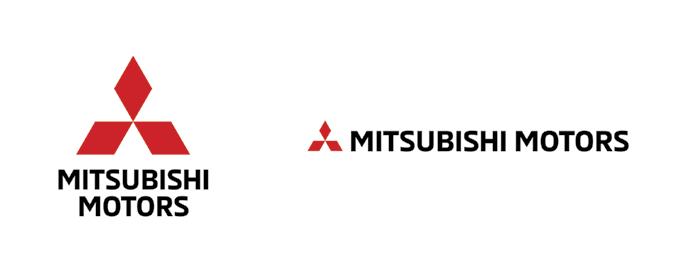

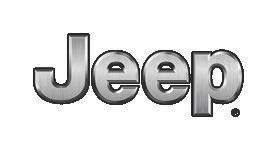
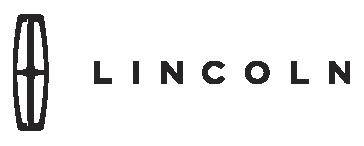
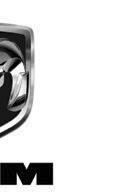

Shop our brands and the largest selection in the Hudson Valley.
The electric vehicle (EV) revolution is here.


It’s powerful. It’s silent. It’s a smooth ride. It has high-end safety features with driver assist. It has more torque and the latest automotive technology. Plus, you can go further, with more EV range. So, you don’t have to worry about taking the scenic route, and you can enjoy every moment of the ride. You’ll be able to locate charging stations with the built-in navigation, and your vehicle can stay powered with affordable home charging kits, that may be eligible for special rebates.



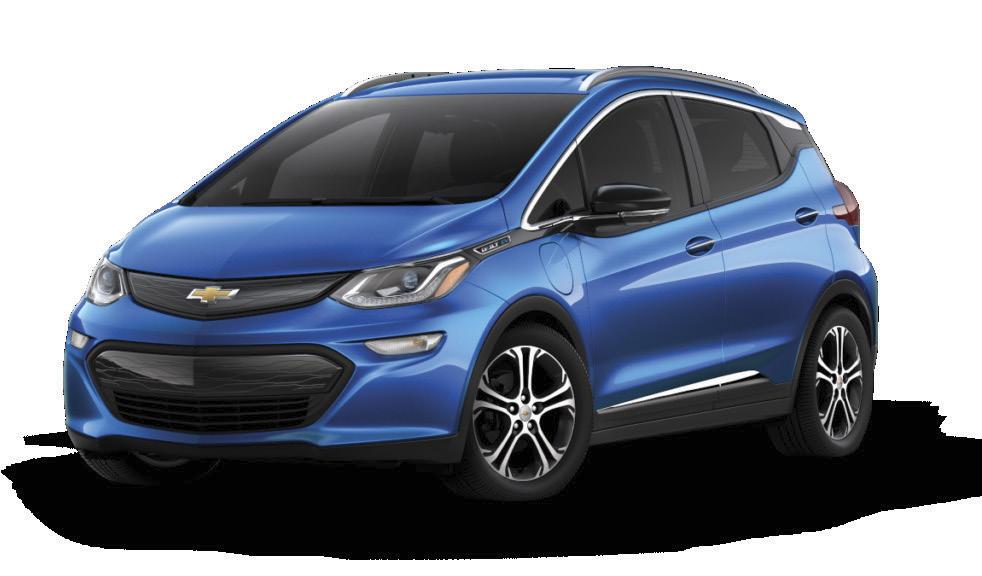
At Healey Brothers, we’ve been leading the way with exceptional service and innovation for nearly half a century. And now, we’re powering the future of EV. We’re locally owned, with more than 500 regional employees you can count on and trust for expert advice and service. We’ll make sure you get the right EV for the journey ahead, wherever it may lead you.
Power your journey. Power your spirit. Power your life with an EV from Healey.
Learn more at healeybrothers.com/ev

How does NYSERDA define community solar and community choice aggregation?

Community solar involves a large array of solar panels, typically at an offsite location, which allows homeowners and renters to access solar clean power without installing panels on their homes. Energy is still delivered through their regular electric provider while the power produced from the community solar array is fed directly back to the electric grid and customers receive credits on their electricity bill. For more information on community solar, NSYERDA’s community choice aggregation (CCA) allows local elected officials to choose where the energy comes from for their community. It’s a program to purchase power in bulk for virtually all homes and small businesses within the participating jurisdiction.
How do they appear on a customer’s electric bill?
Community solar benefits typically appear as bill credits on a customer’s electric bill. In Central Hudson Gas and Electric territory, these are displayed in the “Payments and Adjustments” section under the heading “COMMUNITY DISTRIB GENERATION CREDIT.”
CCA for electricity supply (CCA-Supply) shows as a single line item in the Supply Charges section of a utility bill—as would any third-party ESCO (energy services company) arrangement a customer may have. The line item includes the fixed rate ($/ kWh) and the customer’s usage that month (kWh) with the product of those two values. The degree to which the supplier and/or participation in a
CCA program varies. For example, in Orange and Rockland Counties, the utility specifically identifies the name of the program in which the customer is participating and the selected supplier (for example, “You are part of the Rockland Community Power program with Constellation Energy as the program supplier”)—while in Central Hudson territory, there is only identification of the program supplier with no indication of the program (Hudson Valley Community Power).
Can a customer subscribe to both? Are there benefits or drawbacks of doing so?
CCA customers can still be Community Solar subscribers, and doing so can lower a customer’s electric bills and maximize their support of clean energy and local job growth in their community.
What are the primary benefits to customers of Community Solar and of CCA?
Community solar provides New Yorkers with the opportunity to:
Go solar without installing solar panels on your roof or property. Everyone who pays their own electric bill, including renters and co-op/ condo owners, can participate in a community solar project. You can even subscribe to community solar if you live in an apartment or your home is in a shady area that isn’t suited to solar panels.
Absorb little to no upfront costs. Since you won’t need to install solar panels, the upfront costs of going solar with a community solar provider are minimal.
Save money every month on your electric bill. You’ll see credits every month on the electric bill you receive from your utility. The amount credited each month will depend on the amount of solar energy generated by your selected project.
Lower your carbon footprint and support your local economy. When you choose community solar, you’re not only helping to reduce greenhouse gas emissions, you’re also supporting clean, locally generated electricity. Take on minimal commitment. Community solar subscriptions also have shorter-term options and many offer pay-as-you-go payment terms.
A CCA can allow whole communities to participate in the clean energy economy by ensuring that a greater percentage of electricity is coming from renewable sources. CCA has the potential to simultaneously deliver fixedrate electricity prices and cleaner energy for customers. NYSERDA’s Clean Energy Communities Program recognizes and rewards local governments for their clean energy leadership. By completing four high-impact actions—one of which is CCA—communities can earn the Clean Energy Community designation as well as grant funding to support additional clean energy projects.
For more information on Community Solar and Community Choice Aggregation, visit NSYERDA’s website: Nyserda.ny.gov.
Every community deserves a sustainable future. At Mid-Hudson Energy Transition Inc. (MHET) we believe that future begins with an energy choice.
MHET is a not-for-profit organization helping cities and towns across the Hudson Valley transition to an equitable, clean energy economy. We provide ways for people and businesses to receive their power from local renewable sources while making homes and offices more efficient and healthier.
See us in action in the City of Kingston! MHET along with our partner, PowerMarket, is leading Kingston Community Energy, a Community Choice Aggregation (CCA) program designed to create climate resilient communities by providing options for everyone to share in the ownership and control of energy resources.
To learn how Mid-Hudson Energy Transition can implement a robust clean energy program for your community, visit mid-hudson.energy
Mid-Hudson Energy Transition Inc. is a 501(c)(3) New York not-for-profit corporation





















WaterFurnace geothermal heat pumps provide the reliable and renewable comfort you need and offer the cost savings you want.





With over 16,000 units installed in New York, WaterFurnace geothermal units are the greenest, most efficient, and most costeffective method to keep your home comfortable throughout the year. Plus, current incentives can help reduce the initial cost of switching to geothermal by up to 40%!
Now is the perfect time to switch to a WaterFurnace geothermal unit so you can maximize currently available incentives and keep your home a consistent temperature while continuing to save money all year long.




Visit waterfurnace.com/newyork to learn more about switching to geo, and to get your free custom savings estimate.

WaterFurnace is a registered trademark of

There’s a buzz in the air surrounding the need for energy efficient homes, renewable energy, and clean technology. And rightfully so, since 32 percent of our carbon emissions come primarily from heating our homes and our hot water using fossil fuels. That’s a huge opportunity to reduce climate change by decarbonizing and electrifying our homes. It’s such a big deal that in the newly passed Inflation Reduction Act (IRA), the government has allocated $9 billion in consumer home energy rebate programs to electrify home appliances and for energy-efficient retrofits. Additionally, there are 10 years of consumer tax credits to make homes energy efficient and run on clean energy, incentivizing heat pumps, rooftop solar, and all things “home electric,” such as water heaters, stoves, and clothes dryers.
Knowing where and how to start a home decarbonization and electrification project may seem overwhelming, but it doesn’t have to be. Instead, think of it as an “AWE”-inspiring experience, which is a simple acronym for assess, weatherize, electrify. If you follow those steps, in that order, you’ll be well on your way to making your home healthier, more comfortable, less costly to operate, and better for our planet! Let’s look at each step in greater detail.
A = Assess. An energy assessment is an oftenoverlooked but necessary first step to establish your home’s energy-efficiency baseline. Energy assessors are trained to key into the weakest energy links and advise practical ways to address them. An assessor will measure your insulation levels, determine the “leakiness” of your building envelope, flag
health and safety issues, and check your home’s electrical capacity to handle a full electrification. Additionally, the assessor will evaluate your windows and doors, appliances, water fixtures, lighting, and more. Prior to your appointment, write down any issues you may be experiencing. Do specific rooms feel drafty or too cold in winter or too hot in the summer? Are there moisture issues? If you have a prior home inspection report or architectural plans, have those ready for review. Gather one year of utility bills, so the assessor can understand how much energy your home currently uses. After the assessment, which usually takes two to four hours, you’ll receive a report with a summary of findings and next steps.
W = Weatherize. Your priority recommendations will likely be air sealing any holes in your home’s building envelope and adding more insulation. There are basic air sealing tasks you can complete, so ask your assessor about these. Weatherization improvements pay themselves off quickly, so the sooner you do them, the sooner you start saving money and energy. An important note: Heat pumps are designed to work most effectively with homes that are wrapped in a thick blanket of insulation and don’t have any holes to the outside, so skimping on these upgrades can result in adverse outcomes later. Weatherizing sets your home up smartly and safely for the final step. Just do it!
E = Electrify. This is when you add efficient, clean, and smart technology to your home such as heat pumps, solar panels, battery storage, a heat pump hot water heater, magnetic induction stove, electric
clothes dryer, EV charging, and smart controls. The most popular electric option for home heating is heat pumps (air source or geothermal). These provide comfort more efficiently than fossil fuel appliances and are less costly to operate than electric alone. Heat pumps can also provide inexpensive hot water. There are even heat pump clothes dryers available. Electric, magnetic induction stoves provide a more efficient, safer, and healthier option than cooking with gas or propane. Installing solar panels is an excellent way to offset the increased electrical loads of your newly all-electric home. Adding battery storage provides clean power for outages. The savings you’ll realize from operating a more efficient home and generating your own electricity makes going solar more affordable. Additionally, the IRA prescribes a 30 percent federal tax credit for both solar panels and battery storage. New York also has a state solar tax credit. Many solar installers offer low-interest loans, so be sure to ask. If solar panels aren’t an option, consider enrolling in a community solar program. You’ll often save at least 10 percent off your current electric bill.
Be in AWE of your home! Assess, weatherize, electrify. Three steps toward improving the comfort of your home and reducing your energy usage. Three steps that help lessen the impact of excess carbon emissions from fossil fuels.
Marcy Cleveland is a certified BPI Building Analyst and Building Envelope Professional with her own energy assessment company. She is also a NAR Green Realtor and Earth Advantage Broker specializing in sustainable real estate.

Tom Konrad and Samrat Pathania are skilled volunteer energy coaches with New Yorkers for Clean Power. There is very little they can’t help you to find out about to support your clean energy transition, and if you’re reading this, you are probably eligible for their services. When not helping people have fun reducing their carbon footprints, Tom writes for Altenergystocks.com and chairs the Marbletown Environmental Conservation Commission; Samrat teaches in the Wallkill Schools and co-chairs the Climate Reality Leadership Corps Hudson Valley chapter. We asked Tom for an overview of clean energy progress and Samrat for thoughts on his favorite topic electric vehicles. Reach them via Nyforcleanpower.org.
What’s your background?
I studied mechanical engineering in India, but then worked as a software engineer for many years. I later transitioned to teaching physics, math, and computer science at Wallkill High School.
How long have you been helping people shop for EVs, and what do they generally ask?

I bought my electric vehicle in August 2015. It took me about a year and a half to really understand the technology and marketplace. There weren’t that many people with EVs to talk with. As the number picked up I started seeing more and talking with
folks and ultimately organizing the Zero Emissions Parade in New Paltz. That gave me the impetus to help people buy EVs. I’ve mentored at least three dozen people—gone to the dealerships with them, negotiated prices. I also coach on the phone or Zoom.
What are the most common questions you are asked?
Usually people ask first about charging—where, how, how long does it take? Then there’s usually a question phrased as a comment: EVs are so expensive. That’s an assumption. I usually ask what their budget is. In most cases, people have a budget that can include an EV.
If you look at new electric cars, the lowest price is a Chevy Bolt, which starts around $26,000. It is a fantastic car. It gets more than 250 miles on a charge, and has a good warranty, which is usual with electric cars. It has a hatchback for easy loading and unloading of your stuff. It’s really the car to begin with, a fantastic second car, and a good primary car for most people. I think most people overestimate how much car they need.
Coming January 2023, the Bolt will qualify again for the federal tax credit of $7,500, and in 2024 that will become a point of sale rebate so you can access that beginning in 2024. That’s in addition to the New York Drive Clean Rebate of $2,000. The Inflation Reduction Act has changed the rules to require cars that are assembled in North America to qualify for the tax credit. This has impacted some automakers like Hyundai. In the past, the credit eligibility was based on how many cars were
sold, phasing out after 200,000. Going forward, it will be about whether battery components are manufactured or assembled in North America and if battery minerals are extracted, processed, or recycled in North America. That has quickly led to companies announcing assembly plants and battery manufacturing in North America, so this is complex and a changing target.
So, questions to ask: Does the car qualify for rebate, and do you have the tax exposure to use that rebate? It’s not obvious—you can enter the VIN for the car and find out if it is eligible at the Department of Energy website. My guess is that this process will be made smoother under the new law. (DOE link for checking eligibility Afdc.energy. gov/laws/electric-vehicles-for-tax-credit.)
Don’t the batteries have their own environmental impacts?
Car batteries should outlast the body of the car; 200,000 miles should not be a problem. And then they don’t just die. They will probably find a use for stationary storage until they are recycled, which is being ramped up. That piece is also in the IRA, recycling requirements for batteries will kick in the coming years for the cars to qualify for the tax credits.
DOE has had a strategic project since 2019, ReCell Center, which is about research into recycling batteries and their components. They’ve been making some crucial breakthroughs. Redwood Materials, founded by one of the Tesla leads, will also be a big player. People are looking at battery
technology as if it’s static, and it’s not. Battery chemistries will evolve, and lots of people are working to reduce problematic materials like cobalt. There are many different lithium-ion chemistries and cobalt is not part of them all. We need to keep talking about sustainability while also being cognizant of the fact that fossil fuels are also mined and burned, whereas the materials in batteries can be incorporated into a circular economy.
What about warranties?
Warranties are standard—most have eight years or 100,000 miles of warranty. Just like a computer, when the warranty is over, it doesn’t just stop working, it should go on quite a while longer.
What’s the scoop on maintenance?
There is not much to maintain. Electric motors are very reliable devices. The rest is the battery. Replace your cabin air filter and get your brakes checked as part of your annual safety inspection, that’s it.
What are you most excited about?
The pollution perspective. EVs reduce air pollution and noise pollution, especially in city centers and places with heavy traffic. If you look at the effects of air pollution on humans, especially young children, these chemicals are neuro-degenerative. I think about these children, who are my students, and how pollution exposure makes them less able to focus. Tens of thousands of Americans die prematurely every year from transportationrelated health issues. This is a cost we shouldn’t have to pay.
What are your favorite tech features?
I personally want simple cars. They can be overengineered. I don’t need gizmos in my car. I want high efficiency, which leads to low running costs but also smaller battery packs. That saves the finite resources. There seems to be a movement in the industry turning this way with Tesla and Hyundai being leaders in the efficiency game.
How do you suggest that people do their homework if they are considering an EV?
For info overall, the dealerships are good to ask if you trust the dealership; or make an appointment with the Clean Energy Coaches at New Yorkers for Clean Power.
What do you think surprises people most about using renewable technologies in their homes?
Often it’s just how good it is. A lot of people start fairly skeptical about renewable technologies and then just find, wow, this is better! The biggest example is electric cars; the response, handling and pickup are better. Another fun surprise is there’s no emissions check annually for EVs; just a safety check, so it’s only $10.
The same is true for induction stoves. Once you get used to their quirks and have the right pots to cook on them, they’re better than gas. You must have stainless steel or cast iron, though there
is some aluminum with steel annealed into the bottom to make it induction-ready. It’s instant on and instant off; the only latency is in the heat of your pan.
Air source heat pumps are better, as air conditioners, than any air conditioner you’ve ever had. A lot of them have a dehumidification mode, which works really well.
How long do these technologies last?
Heat pumps last as long as an air conditioner. Electric vehicles are being designed to last as long as traditional cars, 100-200 thousand miles, although we do not yet have a lot of EVs that have more than 100 thousand miles on them. But our longer experience with hybrids shows that they can be as durable as gas cars.
Solar panels themselves typically last 30-plus years with some slow degradation, but the other components of the system, like inverters, may fail sooner. When early solar systems were installed, the plan was to replace the inverters when they failed, but new solar panels and inverters are both more powerful and much cheaper, so a lot of people use the breaking of the inverter as an opportunity to upgrade the whole system.
Having an all-renewable home, how do you have to think differently?

Generally, you don’t have fuel delivery. You don’t have to worry about how much oil will cost this winter; electricity prices also fluctuate (if not as much as oil or propane). But if you have solar, you’re not going to be buying much fuel, so there’s less need to worry about the price.
What kind of maintenance do you need to do for each kind of renewable technology in your home?
My 2012 Toyota RAV4 Electric has 83,000 miles on it and has required less maintenance than a gas car. It’s in the shop over a brake line—the EV parts are working fine. All I’ve had to do in the last four years besides the current brake line replacement is change the windshield wipers and rotate the tires. There’s no combustion engine, so no oil changes, etc.
Solar panels: I’ve really had no problems; you really might as well not know it’s there. Snow shoveling is not recommended; parts of mine are sloped and south facing so it slides off pretty quickly. If it doesn’t get above freezing for a while
or if you have a flat set of solar panels, you might have snow stay there for most of January or February. But it’s March through October when you get 90 percent of solar production, so while it is frustrating to have snow covered panels some winters, you’re not really losing much.
Air source heat pumps: For heating, it’s very important to insulate your home well before installing heat pumps, and to maintain the filters well. Cleaning every month is recommended, though I get away with every six months—it depends on the dustiness of your home.
I have a solar hot water heater, where the sun heats pipes to heat the hot water. I don’t recommend it for most people given the expense. If I did it over, I would use conventional solar plus a heat pump water heater.
All my yard equipment is electric: lawn mower, snow blower, wood chipper, trimmer, chainsaw, etc. Most are easier to use than gas versions—easier to start, plus you don’t have to mess with gas. The snow blower starts right up on a cold day with the push of a button. You can keep multiple batteries charged if you have a long driveway. If you buy the same brand of electric yard equipment, the products usually have interchangeable batteries.
Most people don’t store electricity so much as get credits on their electric bill. The rules have changed since my system was installed in 2014, but you basically get paid for overproduction in summer and use that money to offset underproduction in winter. And you will still be producing some power in winter, so the actual bills will still be lower than without solar.
What if your electricity goes out?
I have a woodstove for heat as backup, and a small DIY battery set up to run my computer, internet, and the fan on the wood stove. The average backup generator will not work with a heat pump, which requires high capacity.
Some EVs can be used to run your home, but you would have to have electrical work done on your home first—just like you would have to have if you had a generator installed. It is easy to buy an inverter and connect the car to specific lowcapacity items, such as lights or charging your phone—or the fan on your wood stove.








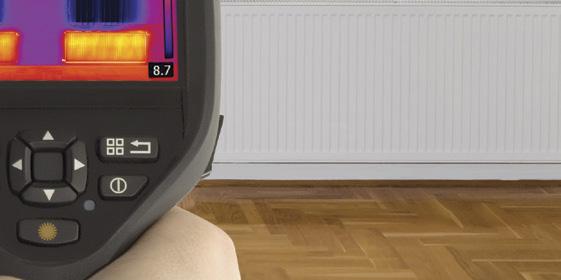






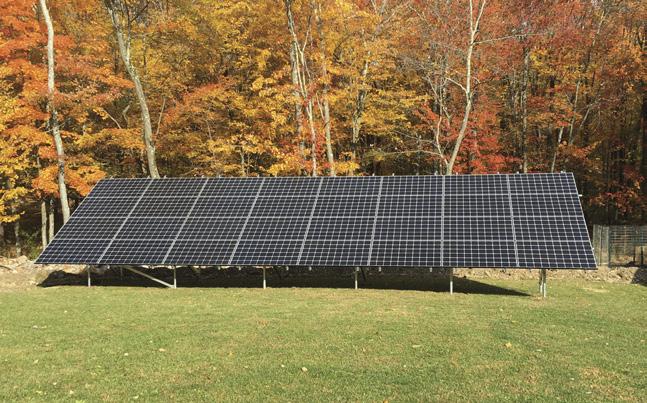




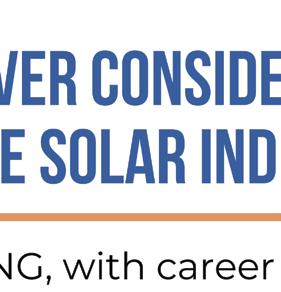





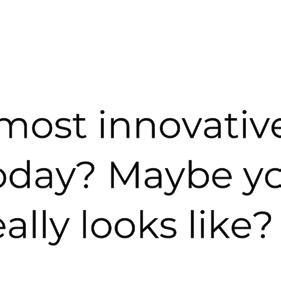

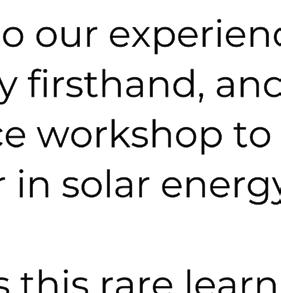


















 BY MELISSA EVERETT, PH.D. EXECUTIVE DIRECTOR, SUSTAINABLE HUDSON VALLEY
BY MELISSA EVERETT, PH.D. EXECUTIVE DIRECTOR, SUSTAINABLE HUDSON VALLEY
As New York’s Climate Law takes effect and brings efficient and renewable technologies into our world at a new scale, an estimated 189,000 net jobs will be created. They include installing and maintaining solar panels and EV chargers, fixing the few things in electric cars that need maintenance, conducting energy assessments in buildings, installing insulation, air sealing, smart thermostats, and heat pumps, putting in geothermal systems for buildings and entire neighborhoods, installing battery storage systems, replacing street lights with higherefficiency models, painting rooftops white to help them reflect heat, selling electric vehicles from cars to bikes to buses. There will be more and more work in sales, marketing, finance, management, training, communications and customer service for all these technologies. If some of this tech is produced in our region, there will be manufacturing and distribution jobs as well.
Not all fields will grow. If you are running a gas station or delivering heating fuel, you will face choices in the next decade. If you doubt that the options are abundant, reread the above. The expanding clean energy economy includes every level from entry to senior professional to management. If you have been delivering fuel and cringe at the idea of climbing on roofs to install solar panels, consider shifting to delivering components and supplies in the renewable energy sector.
What does it take to transition into the clean energy and climate tech economy? That depends on your goals and level of ambition, of course. But a few things apply pretty well across the board.
It’s helpful to understand how the stuff works, and to bring enough basic capabilities in science, math and engineering that you can communicate with the experts, even if you are landing in one of the many jobs that don’t require deep technical expertise. Whether your aptitude is strongest in visualizing and designing buildings or installing
components or calculating system performance, self-knowledge lets you play to your strengths. Experience is a critical part of any transition strategy. The good news is that there are abundant ways to create it. In fact, New York State funds qualified clean energy employers for on-the-job training of workers transitioning from other industries. The internship and apprenticeship opportunities in the clean energy economy are diverse and welcoming to people across the spectrum of skills and lifestyles.
The New York State Energy Research and Development Authority (NYSERDA) offers generous internship funding for anyone in an accredited New York college or university. For up to 480 hours, the program pays 90 percent of wages up to $17 per hour. NYSERDA has also launched a Climate Justice Fellows program, specifically designed to employ people of color, veterans, lowincome and unemployed individuals, and residents of disadvantaged communities. This program provides employers with grants of $37,000 toward salary and $3,000 for mentoring and training services; employers must show skin in the game by providing benefits.
In addition, Communities for Local Power, an organization dedicated to growing a democratic green economy, offers EmPower Kingston. This eight-week paid internship program allows students of any age and background to experience a variety of industries and workplaces.
A technical internship or apprenticeship does not limit graduates to technical fields. Desiree Lyle of Saugerties used the EmPower Kingston program to learn building science and earn key credentials. She then formed a consultancy, Simply Sustainable, which offers a diverse portfolio of services to broaden access to sustainable housing, jobs and education. This year alone, she says, “In addition to teaching and testing buildings, I’m developing an affordable housing project, consulting on clean
energy workforce strategy, and a scientific air quality study.”
Some green jobs are union jobs, and some unions have a long track record in this space. For example, the International Brotherhood of Electrical Workers Local 363, based in Harriman, has earned the prestigious IREC Training Provider Accreditation from the Interstate Renewable Energy Council. To expand access to this union pathway, the Newburgh-based Blacc Vanilla Community Foundation has been mentoring young people, and has referred 17 candidates to the IBEW for training.
To make it easy for entry-level workers to learn the basics in digestible bites, SUNY Ulster has created a series of “stackable certificates” that lead to a certification, Fundamentals of Clean Energy. A basic electrical class, a week of building science and a week of solar installation—taken at the student’s convenience—provide enough basics, confidence and recognition for employability.
For people with business ideas to bake, technology incubators like Columbia’s are well developed and effective. So are graduate programs such as the Bard and SUNY New Paltz MBAs with a strong focus on sustainable business.
There are also abundant and growing networks that can connect you to green businesses. Ulster County recently created UGREEN, the Ulster Green Economy Network. It’s a business to business network designed to grow the marketplace and advise the county on policy. With 42 companies joining in the first month, this network is a portal into quite a diverse ecosystem of enterprises.
As these industries grow, it is getting easier to create a business that reflects your values and special talents. Training programs build skills and understanding of the work. More and more apprenticeship and on-the-job training programs are also available to help people understand the opportunities to build a customized career.
E-bikes are hot. According to Ken Tooker of Pleasant Valley Bicycle Shop, sales are up 40 percent from last year, and in 2021, sales were up 40 percent from the previous year. And it’s not just tech appeal, according to Tooker. “It’s getting to be a social event, with groups of people riding together, for example on the rail trail,” he says. “People with disabilities are buying them. People are trying them and then get their spouses riding too.”
Who should be thinking about getting an e-bike? “Anyone who wants to get outside and have fun and exercise,” Tooker says. And people who want to increase the role of bikes in their mobility. Compared with a conventional bike, e-bikes involve less effort, “You don’t have to worry about getting up hills,” Tooker explains. Pedal-assist e-bikes have a sensor, which kicks in the motor to help you when you need it.

Experienced urban cyclist Dennis Tang suggests looking at four features of any bike: comfort, power, battery capacity, and options like economy mode (using less power for longer range) and sports modes.
Prices may vary from under $1,000 to as much as $8,000 for e-bikes. Riders focused on exercise should investigate e-bikes with adjustable settings for how much help the bike will give you while riding. Potential commuters may want to look for the ability to use the motor exclusively when desired.
“We sell quality, $2,000 and up,” says Tooker of the options at Pleasant Valley Bicycle Shop. “Around here, I haven’t seen many people using them to commute; that’s more in the cities. There are pedal assist and throttle types; we sell the pedal-assist ones only. These have maximum speeds of 20 and 28 mph.”
A poster child e-bike rider is Holly Shader, a recently retired science teacher who hikes, cycles, skis, and loves the outdoors. “I love it!,” Shader says. “I had a Raleigh Detour, a class one electricassist bike with pedaling required and no throttle. It provides assistance to a maximum speed of 20 mph, at three levels: economy, normal, and high, in which the rider can adjust with the push of a button.” Was? Why past tense? Shader’s garage suddenly burned down, destroying the bike, which is soon to be replaced.
“The Hudson Valley is hilly,” she says. “My partner was in much better shape than I was. Having the e-bike allowed us to go on many long, enjoyable rides. I could keep up easily, we could go farther than we would have had I been riding a traditional bike. As I became a stronger rider, I needed the assist less, but it was always lovely to have when going up inclines. It built my confidence and let us focus on the views and the experiences.”
“Although the range was an estimated 50 miles, I found that I could go much further since I did not need the assistance all of the time. We could go on at least three 25-plus-mile rides between charges and the battery charged in a few hours.”
The only downside, for Shader, was the weight of the bike: 35 pounds. “It’s not exactly what you want for a roof rack,” she says. “Platform bike racks are becoming much more common and I will be investing in one soon!”
The throttle type of e-bike may be more powerful and some types go much faster, but they are not legal in New York State parks. And with greater
speed, there is greater risk.
Regulations about throttle e-bikes and maximum allowed speed vary from state to state. It’s important to review New York State DMV rules in detail about maximum speed, what constitutes an e-bike versus a motorcycle or scooter, and where specific types (maximum speed/capabilities) of e-bike may be ridden.
In terms of safety, battery quality is another key; UL-listed batteries are important. Other than that, Tooker advises, “Safety considerations are the same as any cyclist or car regarding following the rules of the road. A helmet is a very good idea, but not required except in state parks.”
Tang has learned by experience about e-bike batteries. “Don’t store them in the cold,” he says. “When storing, set at 80 percent. And get yourself a decent charger—the stock ones may not be that good.”
Having had a couple of accidents in traffic, Tang urges, “If you’re going over 30 mph, get a full-face helmet.”
Buying online may save you money; the prices are lower and some under $1,000. However, Tooker cautions that it’s better to purchase an e-bike where you can get it serviced; it can be harder to get parts for bikes purchased online.
It’s not passed yet, but New York State Senate Bill S3080A, which would establish a ride clean rebate program for electric-assist bicycles and electric scooters, has passed the Senate and is pending a vote in the Assembly.
Sponsored by State Senator Julia Salazar, the draft bill would offset 50 percent of the purchase price of a new electric bicycle or electric scooter with a cap of $1,100.